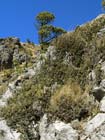Juniperus monticola
Martínez 1946
Common names
Cedro, sabino, sabino de castillo (Pico de Orizaba, Veracruz), tlascal (Hidalgo); mountain juniper (Adams 2004).
Taxonomic notes
Three formae:
- Juniperus monticola Martínez f. monticola, Martínez, Anales Inst. Biol. Univ. Nac. México17: 79 (1946).
- Juniperus monticola Martínez f. compacta Martínez, Anales Inst. Biol. Univ. Nac. México 17:87 (1946).
- Juniperus monticola Martínez f. orizabensis Martínez, Anales Inst. Biol. Univ. Nac. México 17:91 (1946).
Synonymy for Juniperus monticola f. monticola (Adams 2004):
- J. tetragona Schltdl 1838 non Moench 1794.
- Cupressus sabinoides Kunth in Humboldt et al. 1817.
- J. mexicana Spreng. 1826.
- J. sabinoides (Kunth) Nees 1847 non Griseb. 1846.
- J. sabinoides Humb. ex Lindl. et Gordon 1850 non Griseb. 1846.
- Sabina tetragona (Schltdl.) Antoine 1857.
- J. monticola Martínez var. monticola f. orizabensis Martínez 1946.
- J. monticola Martínez var. monticola f. compacta Martínez 1948.
- J. sabinoides (Kunth) Nees var. sabinoides f. orizabensis (Martínez) M. C. Johnst. 1985.
- J. sabinoides f. monticola (Martínez) M. C. Johnst. 1985.
Synonymy for Juniperus monticola f. compacta (Adams 2004):
- Cupressus sabinoides H.B.K. 1817.
- J. mexicana Spreng. 1826 nom. superfl. illeg.
- J. sabinoides (Kunth) Nees 1847 non Griseb. 1846.
- J. sabinoides Humb. (erroneously attributed) in Lindl. et Gordon 1850.
- J. monticola Martínez var. monticola f. compacta Martínez 1948.
Synonymy for Juniperus monticola f. orizabensis (Adams 2004):
- J. monticola Martínez var. monticola f. orizabensis Martínez 1946.
Description
Dioecious evergreen shrubs or trees to 10 m tall. Foliage includes decurrent and scale types. Female cones (berries) are globose, 5-9(-10) mm diameter, blue-black, glaucous, with a soft, fleshy pulp, usually on curved peduncles. Seeds (2-)3-7(-9) per cone, angular, grooved. Pollen shed in the fall. Other characters variable, as described below (Adams 2004).
Adams 2004 provides the following key to the forms: |
1a. |
Mature twigs 5-10 mm. long angle of branching of ultimate twig 50-60 degrees, foliage very dense and
tightly compacted, prostrate shrubs (less than 1 m.), alpine habitat. |
|
f. compacta |
1b. |
Mature ultimate twigs 10-40 mm. long, angle of branching of ultimate twig 40-60 degrees, foliage
loose, not tightly compacted, low shrub to tree (to 10 m.). |
|
2 |
2a. |
Mature ultimate twigs 10-15(-20) mm. long; angle of branching of ultimate twig 40-50 degrees;
foliage not tightly compacted; spreading, tortuous-stemmed shrub to tree to 10 m. |
|
f. monticola |
2b. |
Mature ultimate twigs 20-40 mm. long, angle of branching of ultimate twig 55-60 degrees, foliage
not tightly compacted, shrubs to 1.5 m. |
|
f. orizabensis |
Forma monticola is a tree or spreading shrub with tortuous branches, if a tree, then to 10 m with crown flattened to broadly conic. The bark is 5-10 mm thick, gray to gray-brown, exfoliating in fibrous, longitudinal strips. The terminal whip branches are spreading and tortuous to ascending, the tips occasionally curved, with red-brown to gray-brown bark. Scale leaves are usually opposite, gray-green to green, often thick, 1.0-2.0 mm long, rounded or obtuse with appressed tips, appearing as a string of beads on the ultimate twig. Their margins are finely denticulate, and there is sometimes an obvious resin gland on the surface of the leaf (Adams 2004).
Forma compacta is a prostrate shrub less than 1 m tall with twisted, procumbent branches. The bark is cinnamon brown, exfoliating in thin strips (Adams 2004).
Forma orizabensis is a shrub up to 1.5 m tall with twisted, spreading branches. Trunk bark is light brown, exfoliating in thin strips or plates.
Distribution and Ecology
Mexico. The formae have disjunct distributions, the type in subalpine to alpine settings, the others confined to the alpine zone, as follows:
Forma monticola: Widespread in rocky subalpine (above treeline on Nevado de Colima, Jalisco) oak-juniper, Pinus or Abies forests, as an understory shrub or small tree, at 2,400 to 4,300 m elevation. It is widespread and not of commercial significance, and thus is not threatened (Adams 2004).
Forma compacta: Native in Coahuila (Sierra Mojada), Distrito Federal (Cerro Pelado and Ajusco), Jalisco (Nevado de Colima), México (Popocatepetl, Iztaccihuatl, Tlaloc and Nevado de Toluca), Nuevo Leon (Cerro Potosí), Tlaxcala (Malinche), and Veracruz (Cofre de Perote). It is found at 3000-4300(-4500) m elevation at the alpine timberline (with Pinus hartwegii) above in Calamagrostis and Festuca mountain grasslands, often on rocky sites. The form has no commercial significance, and thus is not threatened (Adams 2004).
Forma orizabensis: Native in Veracruz (Pico de Orizaba, Sierra Nevada, and Cofre de Perote), Tamaulipas (Peña Nevada), where it grows at and above the alpine timberline on rocky sites at 3700-4500 m elevation; and also in San Luis Potosi (Mineral Catoree), where it occurs at 2850 m elevation in oak forest. Although it has a very limited distribution, it occurs in relatively undisturbed alpine sites and is not threatened (Adams 2004).
Hardy to Zone 7 (cold hardiness limit between -17.7°C and -12.2°C) (Bannister and Neuner 2001); the variety not specified.
Remarkable Specimens
No data as of 2023.03.03.
Ethnobotany
Observations
Remarks
Citations
Adams, Robert P. 2004. Junipers of the World: The Genus Juniperus. Trafford Publishing.
Brief versions of the descriptions are available online at www.juniperus.org.
See also
Adams, R.P. and T.A. Zanoni. 1993. Juniperus monticola (Cupressaceae) revisited. Taxon 42: 85-86.
Farjon (2005) provides a detailed account, with illustrations.



